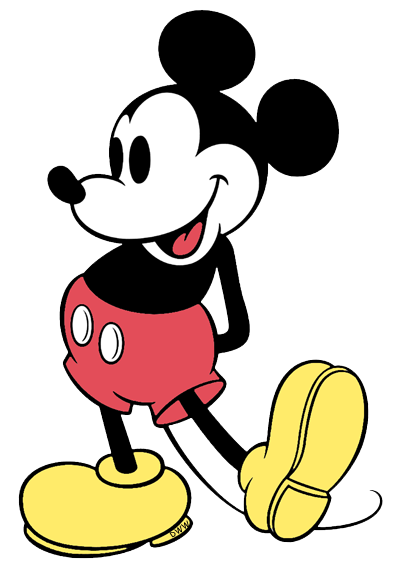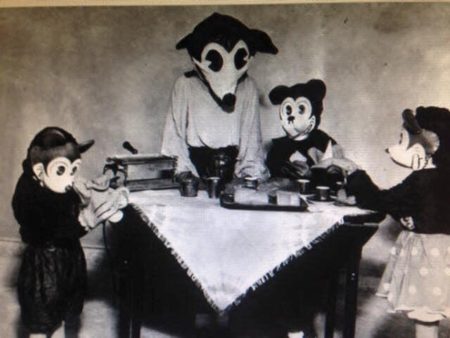A Good American

Mickey wasn’t an immediate hit in the United States — he was briefly more popular in Europe — but soon enough, he was massively popular. By 1932, his popularity had eclipsed that of his predecessor and rival, Pat Sullivan and Otto Messmer’s Felix the Cat. In his brilliant essay “A Biological Homage to Mickey Mouse,” one of his 1970s-era columns in Natural History magazine, evolutionary biologist Stephen Jay Gould would claim that this may have had something to do with how angular Felix was compared with MM; more on Gould’s theory in a later installment of this series.
By linking the distribution of Mickey Mouse cartoons to sales of consumer goods bearing Mickey’s image, Walt and Roy Disney helped develop the motion of corporate synergy. There was a fortune to be made through sales of MM merch — particularly the popular MM wristwatch, but so much more. Clothing, food, school supplies, even razor blades!
Role Model
By the end of 1931, some three quarters of a million children were enrolled in Mickey Mouse clubs. They attended MM performances at movie theaters, sang a theme song, and recited a creed: “I will be a square-shooter in my home, in school, on the playground, wherever I may be. I will be truthful and honorable and strive always to make myself a better and more useful little citizen.… in short, I will be a good American.”

That’s right, Mickey — the libidinous, scandalous, impish trickster — had become a role model for children. Under Mickey’s aegis, American kids were encouraged to be useful, hard-working, and well-behaved. “Mickey… had become virtually a national symbol, and as such he was expected to behave properly at all times,” recounts Stephen Jay Gould. “If he occasionally stepped out of line, any number of letters would arrive at the Studio from citizens and organizations who felt that the nation’s moral well-being was in their hands. … Eventually he would be pressured into the role of straight man.”
Disney story artists began to write Mickey’s roles differently. Alva Johnston, in 1934, took note of the change, which Walt openly discussed with reporters: “Extreme vigilance is exercised to keep [Mickey Mouse] from becoming a smart Alec. Too much whimsy and fantasy are objectionable.”
In his 2006 biography of Walt Disney, Neal Gabler hails “Mickey’s intrepid optimism, his pluck, his naivete that often got him into trouble and his determination that usually got him out of it.” Right — this is the Boy Scout that Mickey became.
Garry Apgar’s Mickey Mouse: Emblem of the American Spirit — the title says it all — describes Mickey’s traits as follows: “boundless energy, optimism, playfulness, independence, spunk, ingenuity, and a certain innocence.”
The Mickey Mouse Scandal
If Mickey was no longer objectionable to American parents, though, his popularity with kids worldwide made even the cleaned-up version of MM seem threatening… to Nazis. Mickey was popular in Germany — a cardboard Mickey effigy can be glimpsed in a pastry shop in Fritz Lang’s M (1931).

A 1931 piece in the Berlin daily Film-Kurier quotes “The Mickey Mouse Scandal,” an article or editorial published by a Nazi affiliate of the National Socialist Workers Party in northern Germany. Offended by the sight of Aryan youth sporting Mickey Mouse lapel pins, the fascist editorial writer blustered:
Blonde, freethinking, urban German youth tied to the apron strings of Jewish finance. Young people, were is your sense of self? Mickey Mouse is the shabbiest, most miserable ideal ever invented. Mickey Mouse is a recipe for mental enfeeblement sent over with capital from the Young Plan. Healthy instinct should tell every decent girl and honest boy that those filthy, dirt-caked vermin, the greatest carriers of bacteria in the animal kingdom, cannot be made into an ideal animal type. Have we nothing better to do than decorate our garments with filthy animals because Jewish business in America wants profits? Down with Jewish brainwashing of the people! Kick out the vermin! Down with Mickey Mouse, and up with the swastika!
Quoted in A Mickey Mouse Reader, ed. Garry Apgar
To their credit, the Film-Kurier argues to the contrary: “Mickey Mouse, come on! We will brandish you as a cheerful emblem for all sensible people who oppose impiety, denial, and murder. Pin little Mickey to yourself as a distinguishing mark against the swastika and provocation.”
This anti-fascist movement didn’t pan out: Hitler was appointed Chancellor in 1933, and the Weimar Republic was soon transformed into a one-party dictatorship based on the totalitarian ideology of National Socialism. But it’s fun to think about: Mickey’s rubbery, round form offers such a striking contrast to the harsh, right angles of the swastika. Fascism is about strength, self-sacrifice, and other supposedly grownup virtues; Mickey — even the post-popularity “straight” version — instead represents childlike wit, whimsy, and free-wheeling individualism.

